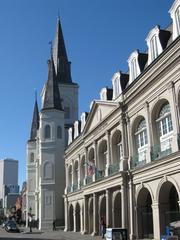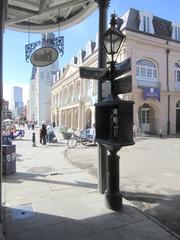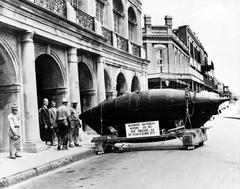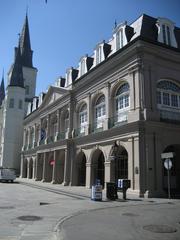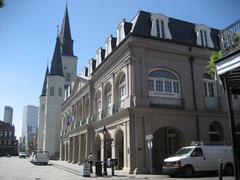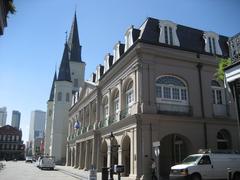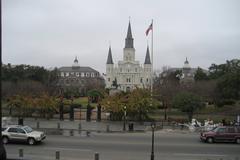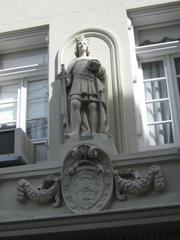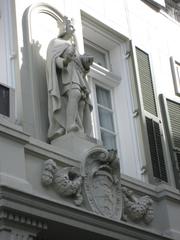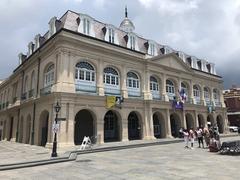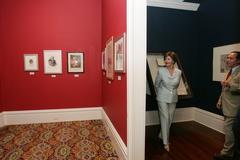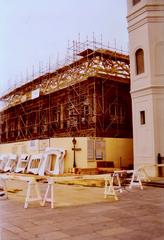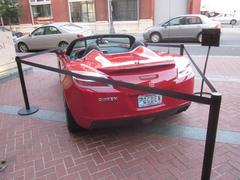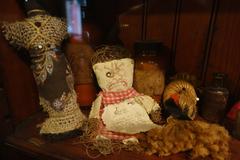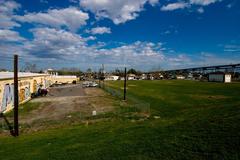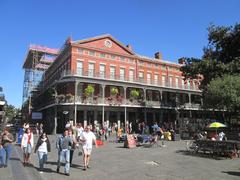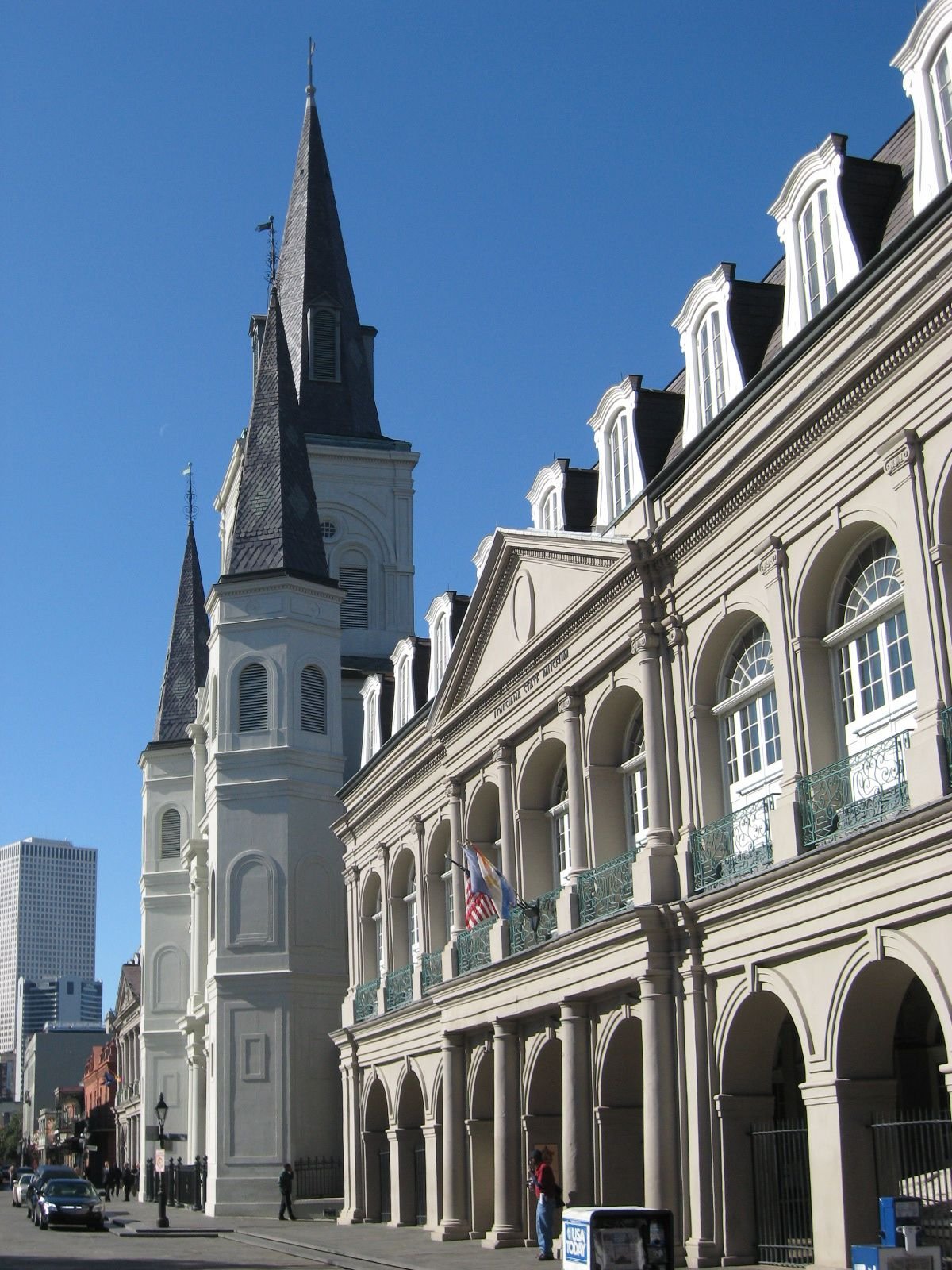
Visiting The Presbytère in New Orleans: Hours, Tickets, and Tips
Publication Date: 24/07/2024
Introduction to The Presbytère
The Presbytère, an architectural masterpiece situated in the heart of New Orleans’ French Quarter, stands as a beacon of the city’s rich and vibrant history. This historic building, originally intended to serve as a residence for the clergy of the adjacent St. Louis Cathedral, has evolved over centuries to become a significant cultural and historical landmark. Designed by the French-born architect Gilberto Guillemard in 1791, The Presbytère’s construction spanned several decades, reflecting the Spanish colonial architectural style with neo-Renaissance elements (Wikipedia). Over the years, The Presbytère has served various roles, including commercial use, a courthouse, and now, a museum. It houses significant exhibits that delve into the traditions and tumultuous history of New Orleans, such as the vibrant Mardi Gras celebrations and the city’s resilience in the face of hurricanes. This guide provides comprehensive information for visitors, including ticket prices, visiting hours, nearby attractions, and special events, ensuring a well-rounded and enriching experience (New Orleans Historical).
Contents Overview
- Introduction
- Historical Background
- Origins and Early Construction
- Architectural Significance
- Transition to Commercial Use
- Role as a Courthouse
- Acquisition by the City and State
- National Historic Landmark Designation
- Restoration and Preservation Efforts
- Current Role and Exhibits
- Cultural Significance
- Visitor Information
- Visiting Hours
- Ticket Prices
- Accessibility
- Travel Tips
- Nearby Attractions
- Jackson Square
- The Cabildo
- St. Louis Cathedral
- Special Events and Tours
- Guided Tours
- Special Events
- Photographic Spots
- FAQ
- Conclusion
Introduction
The Presbytère, an architectural gem in the heart of New Orleans, stands as a testament to the city’s rich history and vibrant culture. This article delves into the historical significance of The Presbytère, provides visitor information including ticket prices and visiting hours, and highlights nearby attractions and special events. Whether you are a history enthusiast or a casual tourist, this guide will help you make the most of your visit to this iconic landmark.
Historical Background
Origins and Early Construction
The Presbytère, originally known as Casa Curial or ‘Ecclesiastical House,’ was designed in 1791 by the French-born architect Gilberto Guillemard. The building was intended to serve as the residence for the clergy of the adjacent St. Louis Cathedral. Its construction began during the Spanish colonial period, reflecting the architectural influences of that era. The first floor was completed by 1798, but the second floor was not finished until 1813 (Wikipedia).
Architectural Significance
The Presbytère is a prime example of Spanish colonial public building architecture in the United States, with many neo-Renaissance elements. It was designed to match the Cabildo, which flanks the other side of St. Louis Cathedral, creating a symmetrical ensemble around Jackson Square. The building’s original design included a flat roof with a balustrade topped by urns, and a nine-bay open arcade of elliptical arches on the ground floor. The upper level also features arched openings, articulated by pilasters, with multipane windows. In 1847, a dormered mansard roof was added, topped by a louvered cupola (Wikipedia).
Transition to Commercial Use
Despite its initial purpose, The Presbytère was never used as a religious residence. Instead, it was utilized for commercial purposes until 1834. During this period, the building’s robust design and strategic location made it a valuable asset for various commercial enterprises (New Orleans Historical).
Role as a Courthouse
In 1834, The Presbytère transitioned to a new role as a courthouse. It served as the home of the Louisiana Supreme Court from 1822 to 1853. This period marked a significant chapter in the building’s history, as it became a center for legal proceedings and judicial activities in New Orleans (New Orleans Historical).
Acquisition by the City and State
In 1853, cathedral officials sold The Presbytère to the city of New Orleans. The building continued to serve various public functions until 1908, when the city sold it to the state of Louisiana. In 1911, The Presbytère became part of the Louisiana State Museum, marking the beginning of its transformation into a cultural and historical landmark (Wikipedia).
National Historic Landmark Designation
The Presbytère was designated a National Historic Landmark in 1970, recognizing its architectural significance and historical importance. This designation helped ensure the preservation and protection of the building for future generations (Wikipedia).
Restoration and Preservation Efforts
Over the centuries, The Presbytère has faced numerous challenges, including fires and hurricanes. Notably, the building’s cupola was blown off during a hurricane in 1913 and was meticulously replaced in 2006. These restoration efforts have been crucial in maintaining the structural integrity and historical authenticity of The Presbytère (Urban Historia).
Current Role and Exhibits
Today, The Presbytère is a key component of the Louisiana State Museum. It houses exhibits that delve into the unique traditions and tumultuous history of New Orleans. One of the most notable exhibits is ‘Mardi Gras - It’s Carnival Time in Louisiana,’ which features an elaborate collection of Mardi Gras artifacts and memorabilia. This high-tech, interactive exhibition traces the celebration from its ancient origins to its modern-day festivities, offering visitors an immersive experience (New Orleans).
Cultural Significance
The Presbytère stands as a symbol of New Orleans’ resilience and commitment to preserving its heritage. Its location in Jackson Square, amidst other historic landmarks, accentuates its significance. The square, with its vibrant atmosphere of artists, musicians, and performers, provides a dynamic backdrop, making The Presbytère’s presence even more profound. Each artifact, photograph, and exhibit within the building tells a story, offering insights into the city’s soul and its multifaceted cultural tapestry (Urban Historia).
Visitor Information
Visiting Hours
The Presbytère is open to visitors from Tuesday to Sunday, 10:00 AM to 4:30 PM. It is closed on Mondays and major holidays. It is advisable to check the official website for any changes in operating hours before planning your visit (Vacations Made Easy).
Ticket Prices
General admission to The Presbytère is $7 for adults, $6 for seniors and active military, and $5 for students. Children under 6 years old can enter for free. Group rates and special discounts may be available; please refer to the official website for more details (Vacations Made Easy).
Accessibility
The Presbytère is wheelchair accessible, with ramps and elevators available for visitors with mobility issues. There are also accessible restrooms on-site. Visitors requiring special assistance are encouraged to contact the museum in advance (Which Museum).
Travel Tips
Visitors are advised to wear comfortable shoes as they may spend a considerable amount of time exploring the exhibits. Photography is allowed, but flash photography and tripods are typically prohibited. It is also recommended to visit early in the day to avoid crowds.
Nearby Attractions
Jackson Square
Located adjacent to The Presbytère, Jackson Square is a historic park that serves as a hub of cultural activities. The square is surrounded by other notable landmarks, including St. Louis Cathedral, the Cabildo, and the Pontalba Buildings.
The Cabildo
The Cabildo is another historic building that forms part of the Louisiana State Museum. It offers exhibits on Louisiana’s history, including the colonial era and the Louisiana Purchase.
St. Louis Cathedral
One of the oldest cathedrals in the United States, St. Louis Cathedral is a must-visit for its stunning architecture and spiritual significance.
Special Events and Tours
Guided Tours
Guided tours of The Presbytère are available and offer an in-depth look into its history and exhibits. These tours are led by knowledgeable guides who provide valuable insights and answer questions.
Special Events
The Presbytère hosts various special events throughout the year, including lectures, cultural festivals, and temporary exhibits. Check the official website for the latest event schedule (Vacations Made Easy).
Photographic Spots
The exterior of The Presbytère, with its historic architecture and picturesque setting in Jackson Square, offers excellent photo opportunities. Inside, the vibrant Mardi Gras exhibits provide colorful and unique backdrops for photography.
FAQ
What are the visiting hours for The Presbytère?
The Presbytère is open from Tuesday to Sunday, 10:00 AM to 4:30 PM. It is closed on Mondays and major holidays.
How much are tickets to The Presbytère?
General admission is $7 for adults, $6 for seniors and active military, and $5 for students. Children under 6 years old can enter for free.
Is The Presbytère wheelchair accessible?
Yes, The Presbytère is wheelchair accessible and has ramps, elevators, and accessible restrooms.
Are guided tours available?
Yes, guided tours are available and provide an in-depth look into the history and exhibits of The Presbytère.
Conclusion
The Presbytère is more than just a museum; it is a cornerstone of New Orleans’ cultural and historical landscape. From its architectural grandeur to its rich array of exhibits, The Presbytère offers a unique glimpse into the city’s past and present. Whether you’re interested in history, architecture, or cultural traditions, a visit to The Presbytère is a must. Be sure to check out the visiting hours and tickets, and explore the nearby attractions to make the most of your trip. Don’t forget to capture some memorable photos and share your experience on social media (Urban Historia).
Sources and Further Reading
- The Presbytère. (n.d.). Wikipedia. Retrieved from Wikipedia
- The Presbytère. (n.d.). New Orleans Historical. Retrieved from New Orleans Historical
- The Presbytère. (n.d.). Urban Historia. Retrieved from Urban Historia
- The Presbytère. (n.d.). New Orleans. Retrieved from New Orleans
- The Presbytère. (n.d.). Vacations Made Easy. Retrieved from Vacations Made Easy
- The Presbytère. (n.d.). Which Museum. Retrieved from Which Museum
